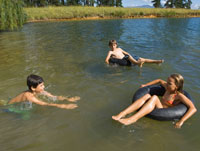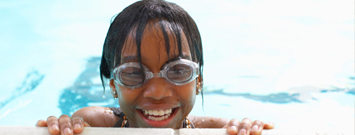NSU Newsroom
SharkBytes
Horizons
This version of NSU News has been archived as of February 28, 2019. To search through archived articles, visit nova.edu/search. To access the new version of NSU News, visit news.nova.edu.
This version of SharkBytes has been archived as of February 28, 2019. To search through archived articles, visit nova.edu/search. To access the new version of SharkBytes, visit sharkbytes.nova.edu.
Stay Safe while Swimming!
Source: Centers for Disease Control & Prevention
Having fun while you swim this summer means knowing how to prevent recreational water illnesses (RWIs) and injuries. Learn how to stay healthy and safe while enjoying the water!
Swimming is one of the most popular sports activities in the United States (1). Although swimming is a physical activity that offers numerous health benefits, pools and other recreational water venues are also places where germs can be spread and injuries can happen.
May 21–27, 2012, the week before Memorial Day, marks the eighth annual Recreational Water Illness and Injury (RWII) Prevention Week. Recreational water illnesses (RWIs) are caused by germs spread by swallowing, breathing in mists or aerosols of, or having contact with contaminated water in swimming pools, hot tubs/spas, water play areas, interactive fountains, lakes, rivers, or oceans. RWIs can also be caused by chemicals in the water or chemicals that evaporate from the water and trigger indoor air quality problems. In addition to illnesses, injuries—such as drowning and slips, trips, and falls—can occur in or around the water.
 RWII Prevention Week 2012 Theme: Preventing Drowning and RWIs
RWII Prevention Week 2012 Theme: Preventing Drowning and RWIs
Drowning Prevention
Drowning is the leading cause of injury death among children 1–4 years old. Every day, 10 people die from drowning; two of those ten are children under the age of 15 years. Of drowning victims who survive and are treated in emergency departments, more than half are hospitalized or transferred for further care. These individuals often experience brain damage that might result in long-term disabilities, including memory problems, learning disabilities, or permanent loss of basic functioning (for example, permanent vegetative state).
To prevent drowning:
- Everyone (adults and children) should know how to swim,
- Caregivers should know CPR,
- All boaters and weaker swimmers should use lifejackets, and
- Backyard swimming pools should be separated from the house and yard by a fence with a self-closing and self-latching gate.
CDC’s Injury Center has additional drowning prevention tips on its Injury Prevention Program’s Resources webpage.
You share the water you swim in with everyone who enters the pool. Contrary to popular belief, chlorine does not kill germs instantly. Once germs get in the pool, it can take anywhere from minutes to days for chlorine to kill them. Swallowing just a little water that contains these germs can make you sick with a recreational water illness (RWI). RWIs include a wide variety of infections, such as gastrointestinal, skin, ear, respiratory, eye, neurologic, and wound infections. The most commonly reported RWI is diarrhea caused by germs such as Crypto (short for Cryptosporidium), Giardia, Shigella, norovirus and E. coli O157:H7.
With the number of RWI outbreaks on the rise, swimmers need to take an active role in helping to protect themselves and prevent the spread of germs. The simple steps below can help you protect yourself and other swimmers from germs in the water you swim in.
Three Steps for All Swimmers
- Don’t swim when you have diarrhea.
- Don’t swallow the pool water. Avoid getting the water in your mouth.
- Practice good hygiene. Shower with soap before swimming and wash your hands after using the toilet or changing diapers. Germs on your body end up in the water.
Three Steps for Parents of Young Kids
- Wash your child thoroughly (especially the rear end) with soap and water before swimming. Even invisible amounts of fecal matter can end up in the pool.
- Check diapers every 30–60 minutes. Change diapers in a bathroom or a diaper-changing area and not at poolside. Germs can spread in and around the pool.
- Take your kids on bathroom breaks every 60 minutes. Waiting to hear “I have to go” may mean that it’s too late.
CDC’s Healthy Swimming website offers a variety of useful materials for the public, including brochures, posters, videos, podcasts, and fact sheets on its Resources webpage. Last year’s Healthy Swimming Video Contest Winner and Runner-Up videos are also available on the Healthy Swimming Videos/TV webpage.
Swim Healthy! Swim Safely!

